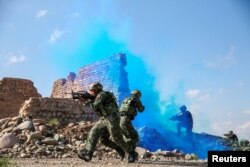Global military expenditure reached its highest level last year since the end of the Cold War, fueled by increased spending in the United States and China, the world's two biggest economies, a leading defense think tank said Monday.
In its annual report, the Stockholm International Peace Research Institute (SIPRI) said overall global military spending in 2018 hit $1.82 trillion, up 2.6 percent on the previous year.
That is the highest figure since 1988, when such data first became available as the Cold War began winding down.
U.S. military spending rose 4.6 percent last year to reach $649 billion, making it still by far the world's biggest spender. It accounted for 36 percent of total global military expenditure, nearly equal to the following eight biggest-spending countries combined, SIPRI said.
China, the second-biggest spender, saw military expenditure rise 5.0 percent to $250 billion last year, the 24th consecutive annual increase.
"In 2018, the USA and China accounted for half of the world's military spending," said Nan Tian, a researcher with the SIPRI Arms and Military Expenditure (AMEX) program.
With President Donald Trump committed to strong national defense despite reducing U.S. troop numbers in conflict zones such as Afghanistan, 2018 marked the first increase in U.S. military spending since 2010, SIPRI said. His defense spending request to Congress this year is the largest ever in dollar terms before adjustment for inflation.
"The increase in U.S. spending was driven by the implementation from 2017 of new arms procurement programs under the Trump administration," Aude Fleurant, the director of the SIPRI AMEX program, said in a statement.
The other top spenders are, in declining order, Saudi Arabia, India, France, Russia, Britain, Germany, Japan and South Korea. Saudi Arabia, which is leading a military coalition battling Iran-aligned Houthis in Yemen, was the biggest per capita spender on defense, just ahead of the United States.
NATO target
Trump has criticized some of Washington's NATO allies in Europe, especially Germany, for failing to meet the alliance's spending target of 2 percent of gross domestic product.
SIPRI data showed military spending equaled 1.2 percent of GDP in Germany — Europe's largest economy — last year, based on GDP estimates for 2018 from the International Monetary Fund.
Britain and France, the two other largest economies in Europe, spent 1.8 percent and 2.3 percent of GDP respectively on defense in 2018.
Military expenditure by all 29 NATO members amounted to just over half of global spending, SIPRI added.
Russia, which flexed its military muscles with its 2014 annexation of Ukraine's Crimea region and intervention in the Syrian conflict, dropped out of the list of the top five spenders in 2018 following an annual decline of 3.5 percent.
Despite a sustained drive to upgrade and modernize Russia's armed forces, President Vladimir Putin has had to tighten purse strings following a sharp decline in global oil prices and the need to prioritize some domestic spending programs.
Russian spending recorded its first annual decline in nearly two decades in 2017, with a fall of 20 percent in real terms, SIPRI estimates released last year showed.







